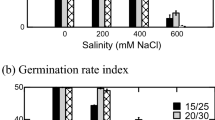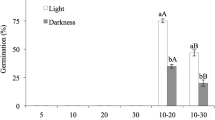Abstract
In arid natural habitats, shrubs are subjected to heterogeneous stressful environmental conditions such as high temperatures, salinity, and drought. It is important to study how native and endemic shrubs respond to these stresses at the germination stage in order to understand these species’ strategies of adaptation to the desert environment. For this purpose, we studied germination of psammohalophyte seeds in conditions of abiotic stress caused by different temperatures (5, 10, 15, 20, 25, 30, 35, and 40 °C), different salt concentrations (0, 50, 100, 150, 200, 250, and 300 mM NaCl), and different water potential values (−0.3, −0.5, −1, −3, and −7 MPa, achieved with use of polyethylene glycol 6000 (PEG6000)) in comparison with control conditions. The final germination percentages and germination speeds of seeds of the following six psammohalophytes were tested: Oudneya africana, Helianthemum lippii, Genista saharae, Retama raetam, Peganum harmala, and Zygophyllum album. The results showed that the degree of response to different temperatures varied between species. The optimal germination temperatures for different species’ seeds ranged from 15 °C to 35 °C. The presence of PEG6000 and NaCl caused decreases in germination percentages and germination speeds in O. africana, R. raetam, P. harmala, and Z. album, whereas G. saharae showed a good response to salinity, with an average final germination percentage of 72.71 ± 6.26% and an average germination speed of 5.18 ± 0.44% day−1. H. lippii behaved in the same way with drought stress (with an average germination percentage of 88.83 ± 0.93% and a very fast germination speed of 6.34 ± 0.06% day−1) as it did with salinity stress (with an average germination percentage of 70.14 ± 5.40% and a germination speed of 4.94 ± 0.38% day−1). In general, H. lippii and G. saharae seeds seemed to be the most resistant to these abiotic constraints. Seed germination of the other species occurred only when these constraints were removed, thereby increasing the chances of seedling survival, which was remarkable in the natural environments they inhabit.
Similar content being viewed by others
References
Baskin, C. C., & Baskin, J. M. (1998). Seeds: Ecology, biogeography, and evolution of dormancy and germination. San Diego: Academic Press.
Baskin, J. M., Baskin, C. C., & Li, X. (2000). Taxonomy, anatomy and evolution of physical dormancy in seeds. Plant Species Biology, 15, 139–152.
Baskin C., & Baskin J. M. (2014). Seeds: Ecology, biogeography, and evolution of dormancy and germination. Academic Press, San Diego.
Bewley, J. D., & Black, M. (1994). Seeds: Physiology of development and germination. New York: Plenum Press.
Bliss, R. D., Platt-Abia, K. A., & Thomson, W. W. (1984). Changes in plasmalemma organisation in cowpea radicle during imbibition in water and NaCl solutions. Plant, Cell and Environment, 7, 601–606.
Bliss, R. D., Platt-Abia, K. A., & Thomson, W. W. (1986). The inhibitory effect of NaCl on barley germination. Plant, Cell and Environment, 9, 727–733.
Breckle, S.-W. (1983). Temperate deserts and semi-deserts of Afghanistan and Iran. In D.-W. Goodall & N. West (Eds.), Ecosystems of the world (pp. 271–319). Amsterdam: Elsevier.
Chapman, V. J. (1960). Salt marshes and salt deserts of the world. London: Leonard Hill.
Chehma, A., Faye, B., & et Djebar, M. R. (2008). Productivité fourragère et capacité de charge des parcours camelins du Sahara septentrional Algérien. Sécheresse, 19(2), 115–21.
Doing, H. (1985). Coastal fore-dune zonation and succession in various parts of the world. Vegetatio, 61, 65–75.
El-Keblawy, A. (2004). Salinity effects on seed germination of the common desert range grass, Panicum turgidum. Seed Science and Technology, 32, 943–948.
El-Keblawy, A. (2013). Impacts of dormancy-regulating chemicals on innate and salinity-induced dormancy of four forage grasses native to Arabian deserts. Grass and Forage Science, 68, 288–289.
El-Keblawy, A., & Gairola, S. (2017). Dormancy regulating chemicals alleviate innate seed dormancy and promote germination of desert annuals. Journal of Plant Growth Regulation, 36, 300–311.
El-Keblawy, A., Bhatt, A., & Gairola, S. (2015b). Storage on maternal plants affects light and temperature requirements during germination in two small seeded halophytes in the Arabian deserts. Pakistan Journal of Botany, 47, 1701–1708.
Fenner, M. (1991). The effects of the parent environment on seed germinability. Seed Sci Res, 1, 75–84.
Gorai, M., Vadel, M. A., & Neffati, M. (2006). Seed germination characteristics of Phragmites communis: Effects of temperatureand salinity. Belg. J. Bot, 139, 78–86.
Gorai, M., & Neffati, M. (2007). Germination responses of Reaumuria vermiculata to salinity and temperature. Annals of Applied Biology, 151, 53–59.
Gutterman, Y., & Agami, M. (1987). A comparative germination study of seeds of Helianthemum vesicarium Boiss. and H. ventosum Boiss., perennial desert shrub species inhabiting two different neighbouring habitats in the Negev desert highlands, Israel. Journal of Arid Environments, 12(3), 215–221.
Gutterman, Y. (1993). Seed germination in desert plants. Berlin: Springer.
Gutterman, Y. (1994). Strategies of seed dispersal and germination in plants inhabiting deserts. Botanical Review, 60, 373–425.
Gutterman, Y. (2002). Survival strategies of annual desert plants: Adaptations of desert organisms. Berlin: Springer.
Huang, Z., Zhang, X., Zheng, G., & Gutterman, Y. (2003). Influence of light, temperature, salinity and storage on seed germination of Haloxylon ammodendron. Journal of Arid Environments, 55, 453–464.
Ismail, A. M. A. (1990). Germination ecophysiology in populations of Zygophyllum qatarense Hadidi from contrasting habitats: Effect of temperature, salinity and growth regulators with special reference to fusicoccin. Journal of Arid Environments, 18, 185–194.
ISTA. (1966). International Seed Testing Association. Proceedings of the International Seed Testing Association, 31, 1–152.
Jurado, E., & Westoby, M. (1992). Germination biology of selected central Australian plants. Aust J EcoI, 17, 341–348.
Karssen, C. M., & Hilhorst, H. W. M. (1992). Effect of chemical environment on seed germination. In M. Fenner (Ed.), Seeds: The ecology of regeneration in plant communities (pp. 327–348). Wallingford: CABI.
Khan, M. A., & Ungar, I. A. (1984). The effect of salinity and temperature on the germination of polymorphic seeds and growth of Atriplex triangularis Willd. American Journal of Botany, 71, 481–489.
Khan, M. A., & Ungar, I. A. (1996). Effects of light, salinity, and thermoperiod on the seed germination of halophytes. Canadian Journal of Botany, 75, 835–841.
Khan, M. A., & Ungar, I. A. (1997). Germination responses of the subtropical annual halophyte Zygophyllum simplex. Seed Science and Technology, 25, 83–91.
Khan, M. A., Gul, B., & Weber, D. J. (2000). Germination responses of Salicornia rubra to temperature and salinity. Journal of Arid Environments, 45, 207–214.
Khan, M. A., Gul, B., & Weber, D. J. (2001). Germination of dimorphic seeds of Suaeda moquinii under high salinity stress. Australian Journal of Botany, 49, 185–192.
Khan, M. A. (2003). Halophyte Psamohalophyte seed: Success and pitfalls. In A. M. Hegazi, H. M. El-shaer, S. El-Demerdashe, R. A. Guirgis, A. Abdel Salam Metwally, F. A. Hassan, & H. E. Khashaba (Eds.), Proceedings of the international symposium on optimum resource utilization in salt affected ecosystems in arid and semi arid regions (pp. 346–358). Cairo: Desert Research Center.
Li, L., & Zhang, X. M. (2007). Germination strategies of two halophytes in Salt Desert of northwestern China. Science in China Series D: Earth Sciences, 50(S1), 115–121.
Monod, T. (1992). Du désert. Sécheresse, 3(1), 7–24.
Neffati, M. (1994). Caractérisation morphologique de certaines espèces végétales nord-africaines. Implications pour l’amélioration pastorale. Ph.D. Thesis. Gent University, Belgium.
Ozenda, P. (1991). Flore de Sahara. 3eme édition mise à jour et augmentée, Ed C.N.R.S., Paris. 662 p.
Pujol, J. A., Calvo, J. F. & Ramirez-Diaz, L. (2000). Recovery of germination from different osmotic conditions by four halophytes from southeastern Spain. Annals of Botany, 85, 279–286.
Schat, H. (1983). Germination ecology of some dune slack pioneers. Acta Botanica Neerlandica, 32, 203–212.
Thanos, C. A., Georghiou, K., Kadis, C., & Pantazi, C. (1992). Cistaceae: a plant family with hard seeds. Israel Journal of Botany, 41, 251–263.
Thanos, C. A., Kadis C. C., & Skarou, F. (1995). Ecophysiology of germination in the aromatic plants thyme, savory and oregano (Labiatae). Seed Sci Res, 5, 161–170.
Tlig, T., Gorai, M., & Naffati, M. (2008). Germination responses of Diplotaxis harra to temperature and salinity. Flora, 203, 421–428.
Trabelsi, H. (2016). Rôle du dromadaire dans la régénération et la prolifération du couvet floristique du Sahara septentrional algérien. Thèse de Doctorat U. K. M. Ouargla.
Ungar, I. A. (1962). Influence of salinity on seed germination in succulent halophytes. Ecology, 43, 763–764.
van Rheede van Oudtshoorn, K., & van Rooyen, M. W. (1999). Dispersal biology of desert plants. Springer Berlin.
Woodell, S. R. J. (1985). Salinity and seed germination patterns in coastal plants. Vegetatio, 61, 223–229.
Zahran, M. A. (1982). Ecologie of the halophytic vegetation of Egypt. In D. N. Sen & K. S. Rajurohit (Eds.), Contributions to the ecology of halophytes (pp. 3–20). The Hague: Dr W. Junk.
Author information
Authors and Affiliations
Corresponding author
Editor information
Editors and Affiliations
Section Editor information
Rights and permissions
Copyright information
© 2020 Springer Nature Switzerland AG
About this entry
Cite this entry
Trabelsi, H., Kherraze, M.E. (2020). Effects of Abiotic Stress on Seed Germination of Some Algerian Sahara Psammohalophyte Species. In: Grigore, MN. (eds) Handbook of Halophytes. Springer, Cham. https://doi.org/10.1007/978-3-030-17854-3_84-1
Download citation
DOI: https://doi.org/10.1007/978-3-030-17854-3_84-1
Received:
Accepted:
Published:
Publisher Name: Springer, Cham
Print ISBN: 978-3-030-17854-3
Online ISBN: 978-3-030-17854-3
eBook Packages: Springer Reference Biomedicine and Life SciencesReference Module Biomedical and Life Sciences




